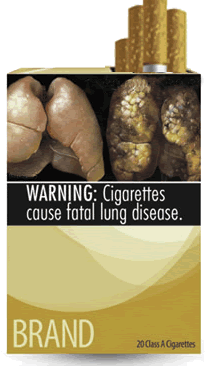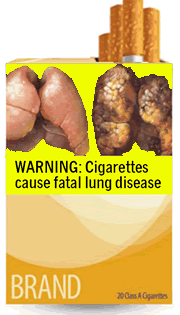April 3, 2013
Stanton A. Glantz, PhD
The warning labels the FDA should implement now
I recently posted a comment noting that I agreed with the FDA’s decision not to appeal the misguided court ruling against the graphic warning labels it had issued. At this point, the question is what the FDA should do now to get warning labels on to the front of the package as quickly as possible.
To quickly get warning labels on the front of the packs, the FDA should issue simple warning labels that are consistent with what the courts have said they cannot and can do.
The court said that graphic warning labels could not:
1. Use “non-factual cartoon drawings.”
2. Use digitally enhanced photos.
3. Use pictures of people crying or graphics that are overtly intended to “evoke emotion.”
4. Require the “1-800-Quit Now” hotline number to be part of the warning label.
However, the Court left open plenty of opportunities for the FDA to design effective warning labels that would pass legal muster and withstand future legal attack. Indeed, in the brief submitted by the cigarette companies in their appeal to the DC Circuit Court, the companies themselves “concede … that they would be amenable to a number of new disclosure requirements “ (DC Circuit, p. 17) and stated that they “never disputed that graphics may sometimes convey purely factual and uncontroversial information,” and that graphic warnings can be effectively designed to provide information – “including as to risks of dependence or death.” (Appellate's brief at p. 24 and p. 30)
Moreover, although the Family Smoking Prevention and Tobacco Control Act (FSPTCA) provisions on the warning labels states that “[t]he text shall be black on a white background, or white on a black ground, in a manner that contrasts, by typography, layout or color, with all other printed material on the package” (FSPTCA Sec. 201(a), 15 USC 1333(a)(2)), FSPTCA also gives the FDA’s express authority to conduct a rulemaking under section 553 of title 5 to “adjust the format, type size, color graphics, and text of any of the label requirements” if “such a change would promote greater public understanding of the risks associated with the use of tobacco products,” (FSPTCA Section 202(d), 15 USC 1333(d)) and as appropriate so that the warnings are clear, conspicuous, and legible.
Since DOJ announced in March that it will not be appealing Judge Leon’s decision, it is time for FDA to use its statutory authority and the guidance provided by the 6th and DC Circuit Courts to conduct a rulemaking pursuant to Section 202 and make some simple adjustments to the warning labels that could have a lot of punch and would satisfy the law as spelled out in the statutes and circuit cases (Sixth Circuit case and DC Circuit Case).
Here are a few guidelines based on what the courts have said is acceptable:
1. Use factual graphics, rather than dramatized pictures (i.e., use graphic imagery in “an objective and evenhanded way”).
2. Use pictures of actual patients, not actors.
3. Use graphics that display information that is purely factual and uncontroversial (e.g., picture of diseased lung).
4. Use graphics that convey objective information about the risks of smoking (e.g., simple graph with average life expectancy of smokers vs. non-smokers).
5. Use photos or graphics of common or likely consequences of smoking (e.g., a photo of tobacco stains on a smoker’s fingers, or simple graphic of parts of body commonly damaged by smoking).
6. Adjust the color and format of the text warnings..
These guidelines provide a first and easy way for the FDA to move quickly to meet its legislative mandate by promoting greater public understanding of the risks associated with the use of tobacco products within the restrictions established by the courts.
Here is one of the warning labels that (except for the 1-800-QUIT-NOW) would meet the courts’ strictures:

This warning could, however, be substantially improved while still remaining “factual.”
Color authorities such as Carlton Wagner (whose research was relied upon by the tobacco companies when they designed their packs) have found that yellow is the most noticeable color, and thus yellow is used on packages to shout out messages like “new and improved” or “free offer!” The combination of black on yellow is “found in nature (and used by humans) … to notify or warn you that you should notice something for your own good: “stinging bees are yellow and black; so are many road signs.” That’s why Wagner advises package designers to “take a lesson from nature, and use [yellow] as an indicator to call quick attention to something.”
By simply changing the background of the text warnings to the same yellow used on highway warning signs (like a school zone warning sign), the FDA would go far to increase their visibility and strengthen their effectiveness. Significantly, the color itself would clearly transmit the fact that it was a “warning:”

FDA should heed this basic advice.
It is simple to implement, and would merely serve to increase the visibility of the factual and uncontroversial text messages that were not challenged by the tobacco industry.
To show how effective this would be I’ve redone one of the factual unemotional labels that simply combined the text warning changing the black background to the same yellow used in school warning signs:
I also deleted the unnecessary ©HHS and period after the warning. It would probably be a good idea to delete the word "WARNING" since the yellow color makes it obvious that this is a warning. Simpler is better.
For packs that are yellow so the road warning sign yellow color does not contrast with the pack color, the FDA should require that the background be bright orange (the same color as road detour signs).
Once this first step has been taken, FDA can revisit warning labels and work to build the legal and scientific case that stronger warnings are legally justified.
(Lauren Lempert helped prepare this blog post.)


Add new comment